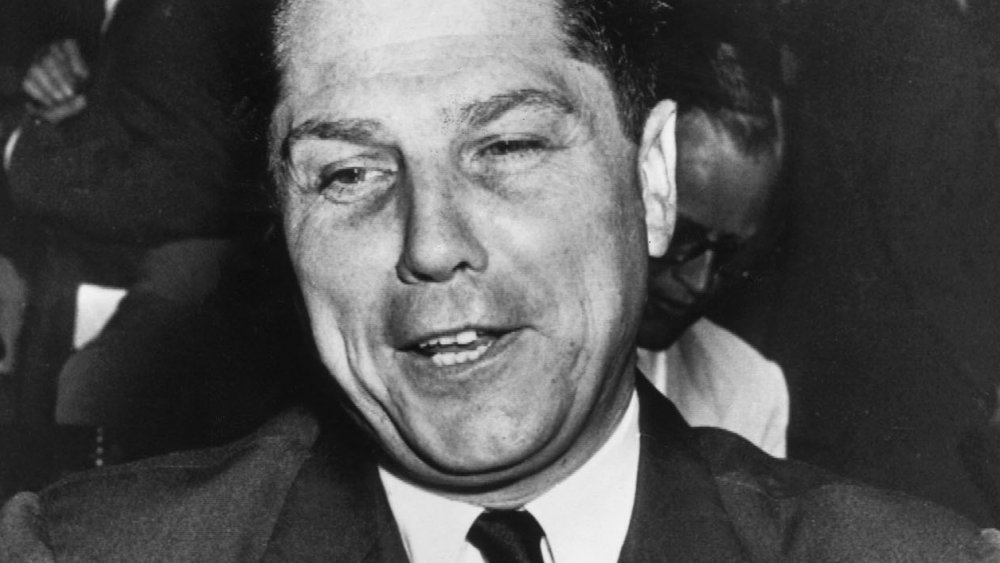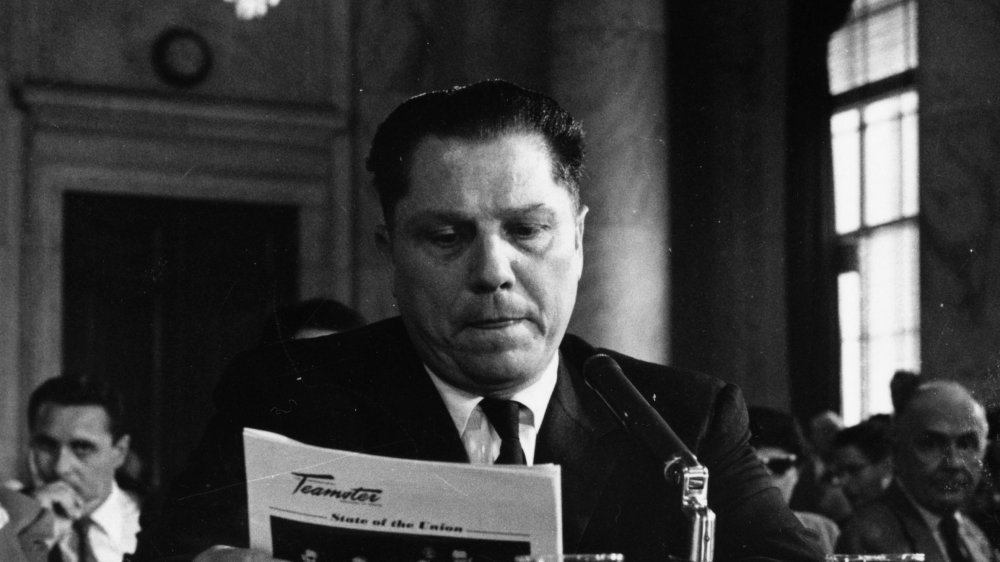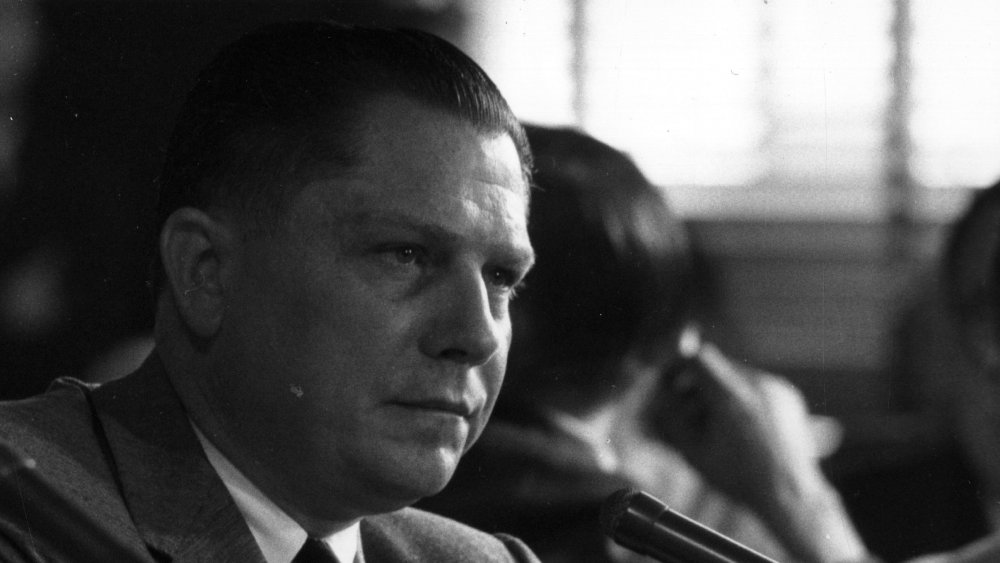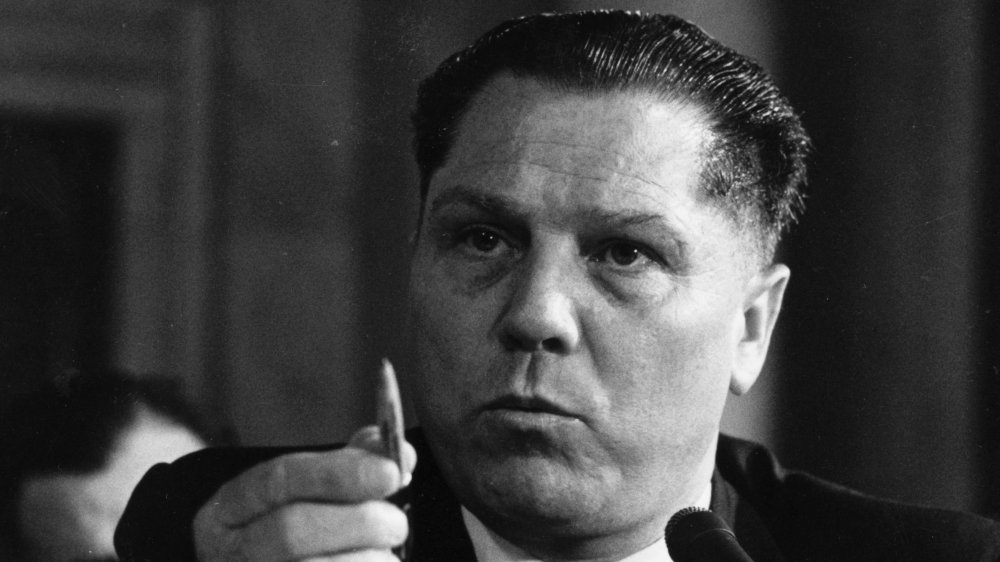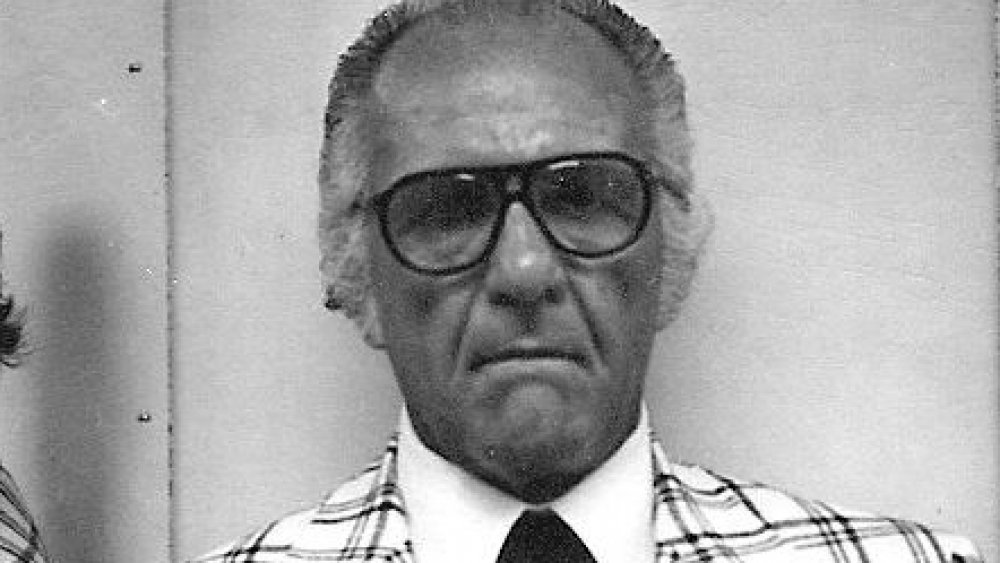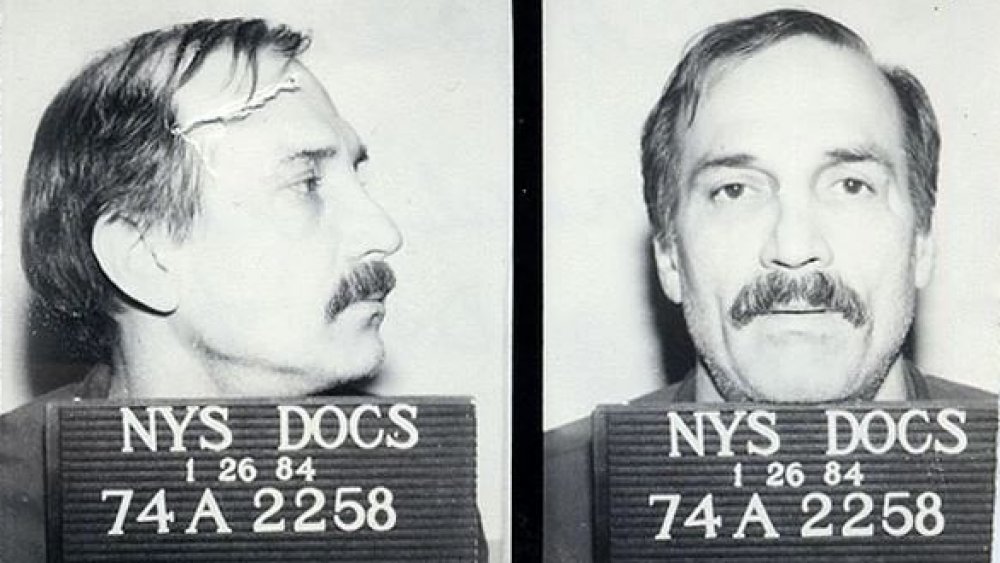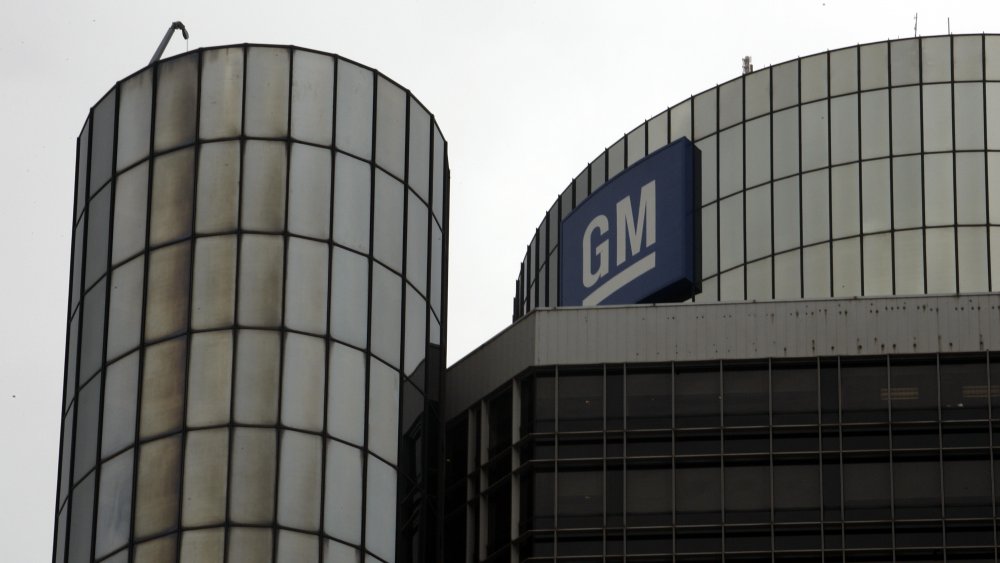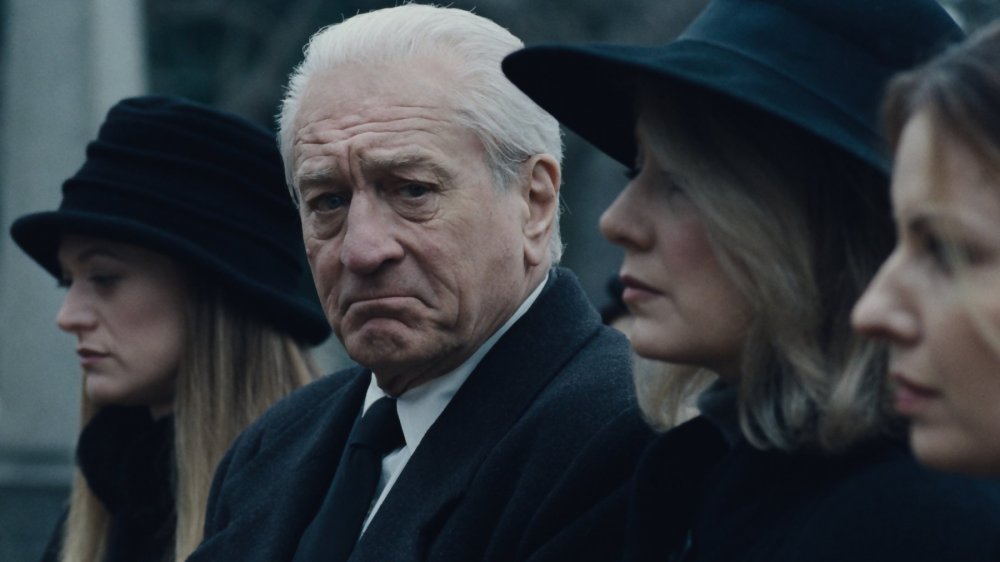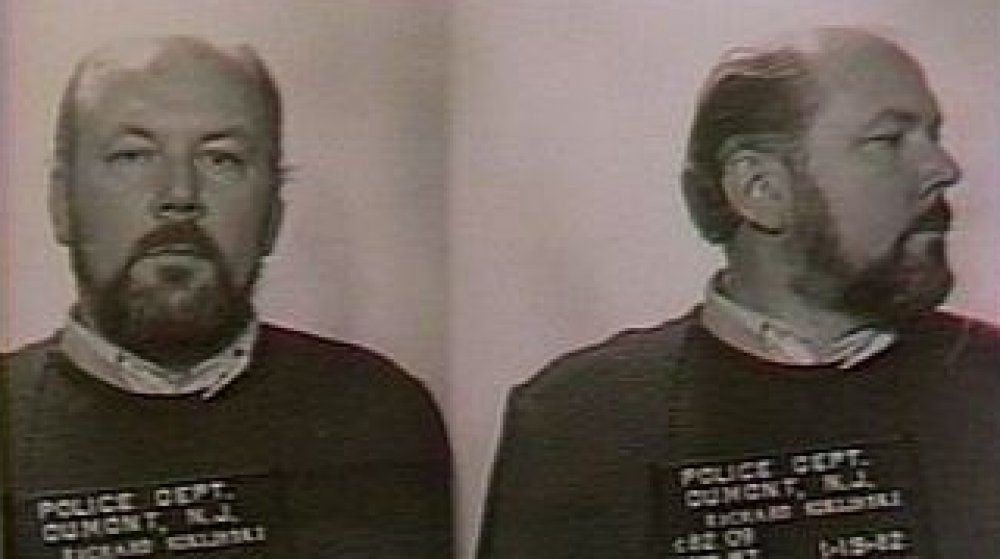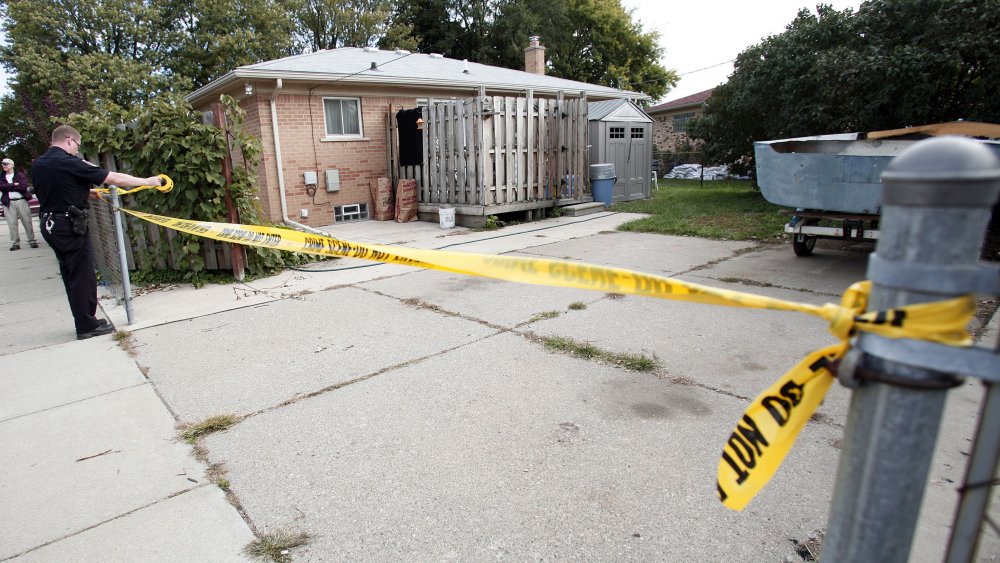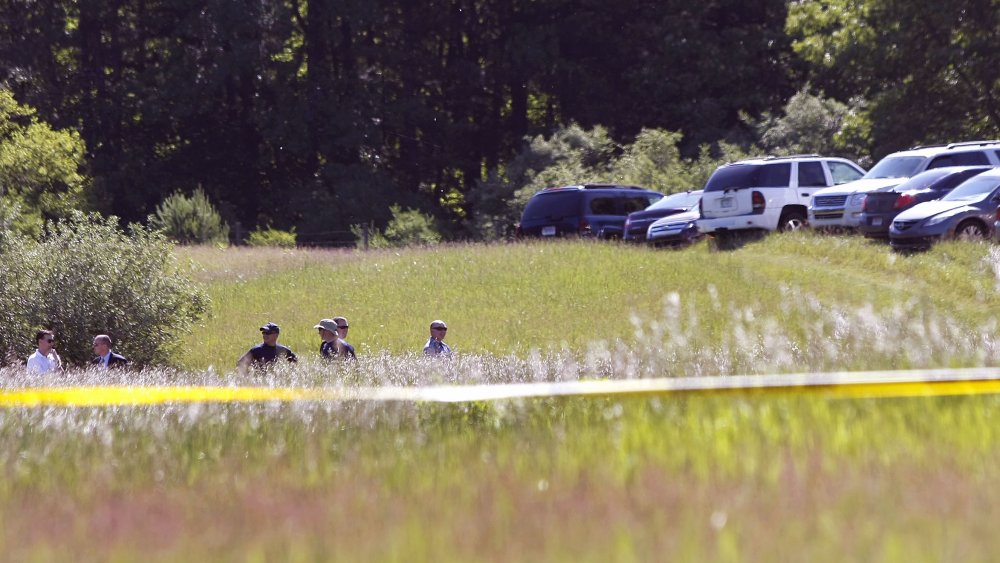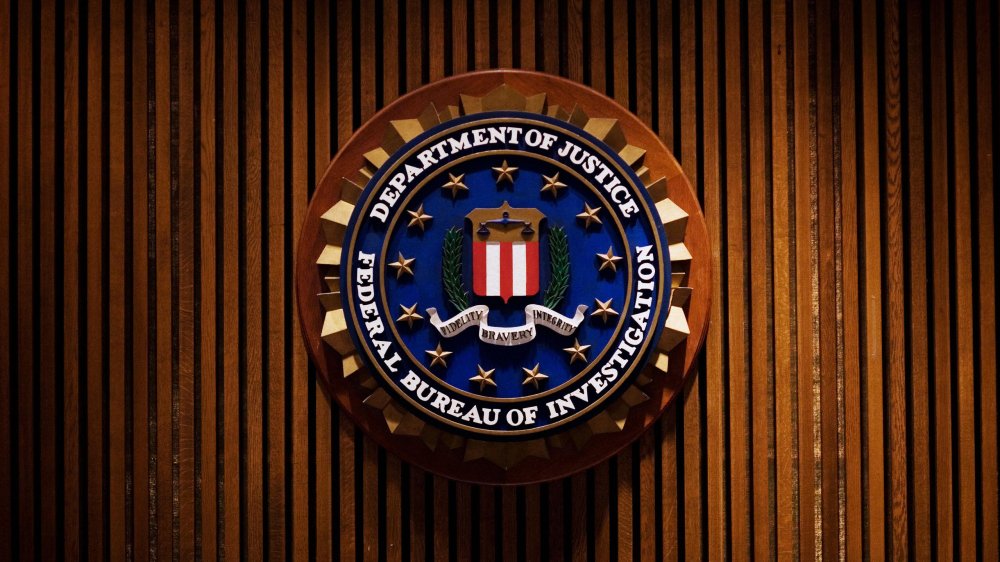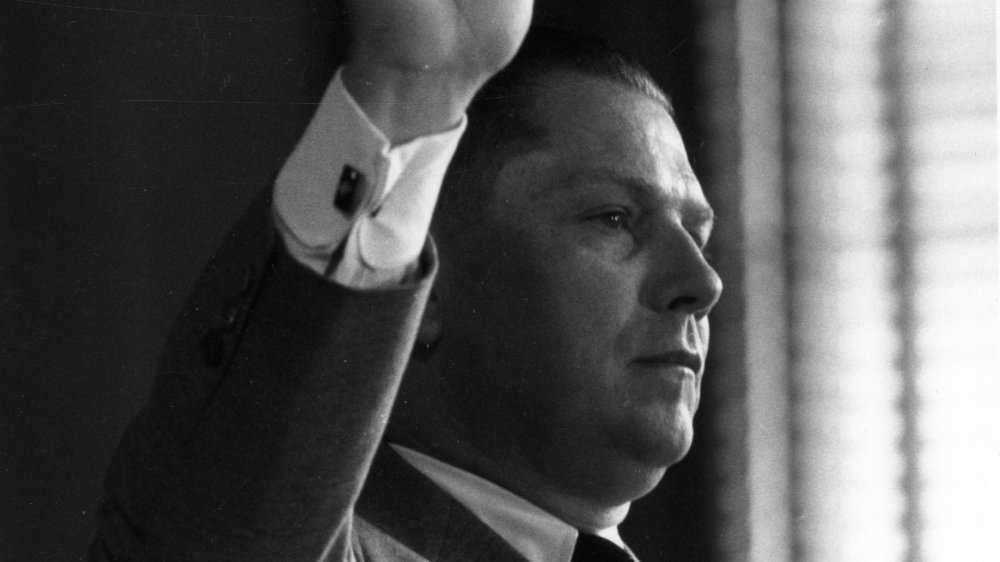What's Come Out About Jimmy Hoffa's Disappearance
Jimmy Hoffa's middle name was Riddle, and the legacy he involuntarily left to the world more than lives up to that moniker. Ever since the union leader mysteriously disappeared in 1975, he has had the kind of publicity his career as a corrupt, yet powerful Teamsters main man could never have given him. Almost every single thing about his last day (as far as the general public goes) remains a mystery: What happened to Hoffa? What was done to him? Who did it and who gave the order? Where, if anywhere, is the body? Lots of people claim to know, but at this point, no one has been able to prove their theories.
We may never be able to solve what is arguably the most famous disappearance case in modern history. What we can do, however, is get comfortable, put on our best Sherlock Holmes deerstalker, and take a comprehensive look at the case from all angles. Come, let's see what the world has learned about Jimmy Hoffa's disappearance in the last few decades.
Jimmy Hoffa's mysterious disappearance
According to Biography, Jimmy Hoffa disappeared on the afternoon of July 30, 1975. We know that around 2 p.m. on that day he was waiting in the parking lot of the Machus Red Fox Restaurant. He was supposed to meet mafia bigshots Anthony Provenzano and Anthony Giacalone, but apparently neither Anthony saw fit to turn up, since Hoffa called his wife at 2:15 p.m., saying that he was "stood up" and that he'd be home by 4 p.m. Of course, that never happened, and this was the last time anyone was in contact with Hoffa ... at least, anyone who is willing to admit it.
On the morning of July 31, Hoffa's Pontiac Grand Ville was still in the parking lot. As Detroit Free Press tells us, the car was unlocked and contained zero clues about its owner's location. Hoffa had been a notorious figure, as were his dodgy connections and the circumstances of his disappearance. One missing person's report later, a mystery for the ages was set to begin.
Early theories about the Jimmy Hoffa case
A public figure and a strange crime are an alluring combination, and as the Washington Post writes, Jimmy Hoffa's sudden disappearance was no exception. However, the state was desperate to keep the FBI out of the investigation because it would freak out their mafia informants which, combined with the rewards that eventually snowballed to over $200,000, led to some pretty strange tips and lines of investigations, such as several officers digging up a field for three days only to find one dead dog. There were several crank callers, such as the guy who claimed he'd kidnapped Hoffa for the kingly ransom of $500, and the one who claimed that a character known as "monster man" who supposedly knocked Hoffa off with a baseball bat and hauled his body to a swamp in Florida. Hoffa's family didn't exactly help reel in the madness, either, as they enlisted a hypnotist to interview employees of the Machus Red Fox restaurant.
The FBI's end of the investigation didn't get any less weird. They kept raiding unsavory locations and finding the occasional (wrong) body, but seemingly all routes led to the other kind of dead ends. As such, the first five years of the investigation were a wild ride, and by 1980, a whopping 70 witnesses had faced a federal grand jury. None were indicted.
Jimmy Hoffa's driver was a major suspect
Every crime mystery needs a primary suspect, and in the Jimmy Hoffa disappearance case, that role went to Chuckie O'Brien. As the Atlantic tells us, O'Brien was a longtime acquaintance and aide of the labor leader, but they fell out in late 1974. When Hoffa disappeared in the summer of 1975, Biography records, O'Brien said he had nothing to do with the case. Still, a swath of circumstantial evidence linked him to the case, and police dogs even discovered Hoffa's scent in a car that had been loaned to him. This made him the primary suspect well into the 1990s, when the investigators finally started opening up to other options.
According to Harvard Gazette, O'Brien's stepson is law professor Jack Goldsmith, who has his own ideas about his stepdad. Goldsmith says that O'Brien was indeed near the scene of disappearance, and that he was driving the car Hoffa's scent was found in, but he was merely delivering fish and probably had no part in the actual disappearance. However, Goldsmith admits that O'Brien, who lost his reputation and career because of his supposed involvement, did in fact know at least something about the case, and the reason he stayed quiet and took the blame was his unwillingness to become a "rat."
Jimmy Hoffa and the two Anthonys
One of the most oft-mentioned suspects in the Jimmy Hoffa case is Anthony "Tony Pro" Provenzano, a New Jersey mob boss who the Los Angeles Times tells us had ties to the Genovese family. Reportedly, Hoffa had beef with Provenzano and his fateful meeting was supposed to be a parlay. However, Tony Pro no-showed, and was suspiciously visible in New Jersey during the time of Hoffa's disappearance in Detroit, giving him a rock-solid alibi.
According to Deadline Detroit, another Tony often linked to the death was Anthony Giacalone (pictured), who was one of the public "faces" of the Detroit mob under Joe Zerilli, and who some experts believe conspired to silence the Teamster. Biography notes that Giacalone was also supposed to be at the Provenzano-Hoffa meeting, but as "luck" would have it, Giacalone also happened to have an airtight alibi for the day Hoffa vanished, as he was hanging out in front of witnesses at the Southfield Athletic Club. Oddly, some experts have pointed out that his brother and fellow mafia capo Vito Giacalone seemed to fly under the radar ... oh, and the Mercury Marquis Brougham car where the dogs caught Hoffa's scent — the one supposedly driven by Chuckie O'Brien — actually belonged to Anthony Giacalone's son. Hmm.
Jimmy Hoffa, Tony the Greek, and the New York Giants
As AP News tells us, one of the more colorful figures around the Jimmy Hoffa case was Donald "Tony the Greek" Frankos (wait, does everyone have to be called Tony?), an alleged freelance hitman who was already on the national radar for his role as a witness in the trial of John Gotti. In 1989, Tony the Greek told Playboy magazine that he knew Hoffa's final fate, and had in fact told the FBI about it as early as 1986. According to Mr. the Greek, Hoffa's killer was (alleged) Irish Mafia bigshot Jimmy Coonan, and the deed was done in a mob house near Mount Clemens, Michigan. After the union leader was shot, his body was then dismembered and buried beneath the Giants Stadium (the New York Giants' home stadium before they moved to MetLife Stadium) — in the concrete underneath the artificial turf near Section 107, to be precise.
This particular theory is obviously intriguing, but doesn't seem to have gained too much traction among the officials, who have called it "possible but ... improbable." Mythbusters arrived to the same conclusion when they spent an episode looking for Hoffa's remains on the stadium, and ultimately deemed the myth busted.
The General Motors headquarters theory
In 2011, a book called The Weasel: A Double Life in the Mob added another intriguing location to the list of potential places housing Jimmy Hoffa's mortal remains. According to Pittsburgh Post-Gazette, the book's authors — a low-level mobster-turned-informant named Marvin Elkind and mafia expert Adrian Humphries — claim they have knowledge that Hoffa never left Detroit. In fact, he's buried in the foundations of the General Motors headquarters at the city's Renaissance Center. Elkind says he found out about the location of Hoffa's body, as well as the man who killed him, in 1985 during a Teamsters event in Detroit. As his group was passing the Renaissance Center's construction site, mafia boss Anthony Giacalone gave a nod at the foundations and told them: "Say good morning to Jimmy Hoffa, boys."
Whether you choose to believe this particular story or not, it's worth noting that Biography tells us Giacalone was reportedly one of the guys Hoffa was supposed to meet right before his disappearance. Was he just using his reputation to wind up the Teamsters? Or did he casually admit his role in Hoffa's murder? The world may never know for sure, especially as Giacalone passed away in 2001.
The Irishman enters the scene
The story of Jimmy Hoffa's friend and confidant Frank "The Irishman" Sheeran playing a part in Hoffa's disappearance is arguably the most high-profile Hoffa theory currently out there, thanks to Francis Ford Coppola's 2019 movie The Irishman, where Robert De Niro stars as Sheeran and Al Pacino plays Hoffa. History Vs. Hollywood says that the movie is based on the book I Heard You Paint Houses, which tells the alleged story of the cold-blooded Sheeran befriending and eventually murdering Hoffa. The book, which claims to be based on Sheeran's deathbed confessions, also claims that he acted as a muscle for Hoffa, and even killed people at the behest of the union leader.
Unfortunately, the story the movie spins may be an utter fabrication: according to Slate, many the Irishman's contemporaries think the whole thing is complete "baloney, beyond belief." In fact, no one who knew the man seems to think that this supposed stone-cold killer of up to 30 people was ever even fleetingly suspected of killing anyone whatsoever.
The Iceman cometh
As the Guardian reports, one of the strangest and most notorious people to throw their hat in the "I killed Jimmy Hoffa" ring is Richard "Iceman" Kuklinski. The notorious mafia hitman was sentenced to prison for five murders in 1998, and died there in 2006. The imposing, 6'5" Kuklinski claimed to have killed his first man when he was only 14, and that he "practiced" new methods of mayhem by killing homeless people. His cold-blooded nickname came from his ruthlessness and a case where he froze a body to throw investigators off about the time of death.
Kuklinski claims that he was among the group of gangsters who shanghaied Hoffa and drove him away. According to the Iceman, he knocked the union leader unconscious and stabbed his head with a hunting knife. Then, he drove to New Jersey with Hoffa's body in the trunk of a car that was "crushed and sold [as] scrap metal." However, the Iceman has claimed to have been a part of multiple high-profile mafia crimes, and boasts an utterly unproven death tally of over 100 murders. As such, some experts think his Hoffa story is pure fantasy. As former FBI agent Robert Garrity puts it: "That's the most embarrassing one to date."
The Roseville driveway
In 2012, CNN told us about yet another unexpected development in the Jimmy Hoffa disappearance case, as the investigators received a tip about a man who was in cahoots with Anthony Giacalone, the man who Hoffa was supposed to meet on the day he disappeared. According to the tipster, who had waited for so long to come out with the information because he was afraid, this former mobster had installed a brand new concrete driveway on his property in Roseville, Michigan, in 1975, around the same time Hoffa disappeared. Intriguingly, the tipster also said that there was a body buried under the concrete.
While Police Chief James Berlin thought that the tip was credible and the person had indeed witnessed a "burial," he also noted that the possible body was unlikely to be Hoffa's. Dan Moldea, the author of The Hoffa Wars and the recipient of the tip, agreed with Berlin, noting that Hoffa's body was unlikely to be buried "in full view of the neighborhood." According to Detroit Free Press, the driveway was nevertheless excavated and the authorities indeed found an "anomaly" roughly two feet beneath the surface. However, like all "anomalies" the investigation had discovered so far, it wasn't Jimmy Hoffa.
A new lead out of left field
The year 2013 saw yet another search for Jimmy Hoffa's remains. As the Guardian reports, the newest "he was totally buried here" location was a field near Oakland Township on the outskirts of Detroit. As the Detroit Free Press tells us, a joint force of the FBI, the local sheriff's office and Bloomfield Township Police descended upon the field thanks to a tip from Anthony Zerilli, an elderly mobster who claimed to know that Hoffa was buried in the vacant lot. Zerilli's tale of Hoffa's demise was even more terrifying than most stories of the union leader's passing. According to him, Hoffa was taken to the field, hit with a shovel... and buried alive under a concrete slab. Grisly.
Unfortunately (or perhaps fortunately, given Hoffa's awful fate in this particular version of event), the tip turned out to be yet another dead end, and the search ended with the discovery of precisely zero missing Teamster leaders.
The FBI allegedly knows the identity of Jimmy Hoffa's killer
Isn't it strange that the FBI has investigated the disappearance of a high-profile union leader for decades without cracking the case? As ABC News reports, there are people who think that the Feds actually know who made Jimmy Hoffa "vanish," but the agency is just too embarrassed to admit it.
According to prime suspect Chuckie O'Brien's stepson, Harvard law professor Jack Goldsmith, the FBI focused on O'Brien because he was a long-time acquaintance of Hoffa who had recently fallen out with him, and happened to be near the Machus Red Fox restaurant on the morning of the day Hoffa disappeared. The professor admits this was a perfectly valid reason to include O'Brien on the list of suspects, but claims that the Feds leaned on him so hard and for so long that they were eventually unable to admit they were in the wrong. He says that multiple federal agents know perfectly well who actually killed Hoffa, but have kept quiet because they don't want to deal with the red tape. According to Goldsmith, "They just didn't want to take the political heat, admitting they had basically accused the wrong person — or let linger the accusations against Chuckie for 40 years." However, while Goldsmith claims he knows the identity of the real killer — a particular low-level mobster who has already passed away — he has chosen to keep the perpetrator's identity as a secret.
The Fox News correspondent who wants to solve the Jimmy Hoffa mystery
One of the more recent developments in the Jimmy Hoffa case came in 2018, when Fox News correspondent Eric Shawn wrote an opinion piece where he called the FBI to release their files on Hoffa, believing this would solve the disappearance "by the stroke of a pen," and quoting a former U.S. Attorney General and an ex-federal prosecutor who both agree that transparency would be the best way to go. In an interesting twist, Shawn says that he actually has some revealing information that indicates the Agency may well be sitting on something: the Fox News man says that he actually found traces of human blood from a house near the Machus Red Fox restaurant in 2004 while investigating the Frank Sheeran theory, following a lead he says that the Irishman himself gave him.
As you can probably guess by the fact that this discovery was made so many years ago, the blood didn't exactly crack the case. Detroit Free Press reports that the FBI says the blood was definitely human but not Hoffa's, while Shawn claims the DNA testing was largely inconclusive. Regardless of what the truth is, here, it certainly appears that someone met a grisly fate at a house suspiciously close to Hoffa's place of disappearance.
